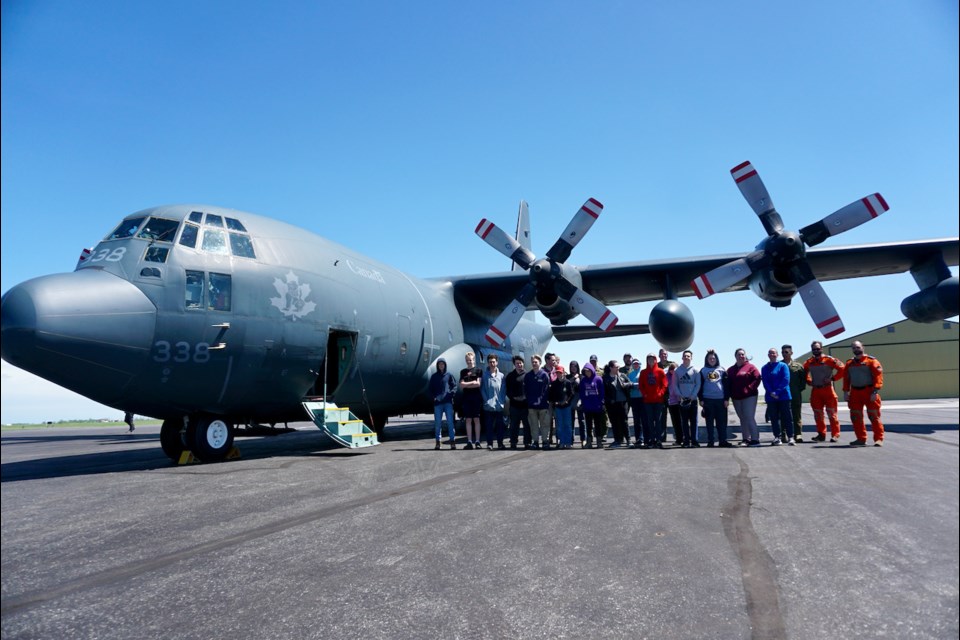ESTEVAN — The skies over Estevan buzzed with excitement on May 30 as the 435 Transport and Rescue Squadron out of Winnipeg arrived in Estevan with their C-130 Hercules aircraft to do some training out of the local airport.
The visit was also a significant event for local cadet groups, their parents and leaders, providing an opportunity for hands-on learning and interaction with military personnel.
"We were lucky enough to be able to talk to the air force here and actually have them land so that the kids could have a look at the aircraft and talk to the crew, and search and rescue technicians," said Craig Bird, the commanding officer of the No. 2901 Estevan PPCLI Army Cadets, who co-ordinated the visit.
"It's always positive because we don't have a lot of military presence down here in the southeast, so anytime that we can actually get military aircraft and actual airmen to come down here, it's a good bonus for the kids and something that they wouldn't normally get exposed to."
The squadron's presence was a unique chance for the army cadets and the No. 30 Wylie-Mitchell Royal Canadian Air Cadets to engage with real military operations.
"The kids were trying on parachutes and talking to the pilots. It's a good bonus for them and something they wouldn't normally get exposed to," Bird added.
Captain Adam Rietman, who serves as Aircraft Commander for the 435 Squadron, emphasized the importance of such visits.
He noted that "it's super important" for the public to see the tax dollars at work and the positive impact of the military.
"It's not all just pointing guns and stuff like that; we save Canadians. That's why I got into the military myself, because of the search and rescue aspect of it," he explained.
Rietman, a former air cadet himself, highlighted the program's influence on his career, noting, "The air cadet program pretty much set me on the track to who I am today."
The Estevan Regional Airport's relatively low traffic and excellent facilities made it an ideal location for the squadron's training exercises.
"They like the airspace around here because it's not as busy as other municipal airports, and they've got a first-class facility here with a runway that can handle the big aircraft," Bird said.
"It's fantastic for our training needs, since it's an uncontrolled airspace and you do have local traffic. So, it's really good work for us to de-conflict with them, but it's not too, too busy that we really have to delay our training or anything like that. And at the same time, sometimes you get thunderstorms but more or less you're going to have all the sunshine so it's perfect for our needs," Rietman said.
During their latest visit, the squadron's search and rescue technicians practised parachute jumps, but the crew noted that they come to Estevan as often as every couple of weeks for training. Their activities include different scenarios such as search area practice, equipment drops, and more exercises vital for real-world readiness.
Rietman noted they have to practise and be ready for any kind of situation, as some of their worst deployments included parachuting in a blizzard in the Northwest Territories last winter and operating in high crosswinds.
"The most challenging are probably those high crosswinds. Sometimes you're trying to beat a thunderstorm and sometimes you're going to get those wicked gust fronts, up to 60 knots gusting, those can be some really challenging conditions," Rietman said.
"And for me myself, it's probably when those winds are like 40 gusting to 60 down the pipe or those high crosswind landings [with wind coming] straight from the side of the aircraft, trying to blow the aircraft off the runway and you got to manage it. Other times it's really low visibility," he said, naming some of the conditions they get to deal with when deployed for search and rescue operations.
The cadets' excitement was palpable, with many expressing sincere interest in the plane and what the squadron does for the job.
"I was an air cadet myself and seeing these kids get exposure to military operations is fantastic," Rietman shared. "It's great to see the future of the air force in these young cadets."
He added that cadet programs, be it army, sea or air, and a military career are something people should try.
"If you're kind of lost, don't know what to do, just walk into a recruitment centre. They're very knowledgeable, they can help you out. Ask questions and we have a lot of help to get you to where you need for training … and a lot of the skills are transferable into the public sector. So I highly recommend it," Rietman said.
Bird noted that he will have a debrief session with the cadets about this experience and they hope to host the 435 Squadron again in the future, continuing to inspire local youths and foster community engagement with the Canadian Armed Forces.





